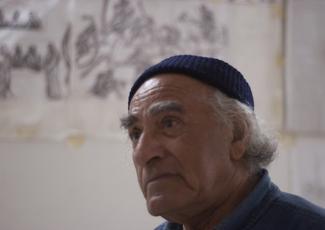Politics and wars decimate history, memory, geography, architecture, human life and art. No city knows this better than Baghdad. Baghdad has been battered by decades of war and has lost among other things a sense of normalcy that human existence thrives on. In the worst of times, art comes to the rescue of the human spirit and reminds it of not just what is lost but what is inviolate. Mohammed Ghani Hikmat, (1929 – September 12, 2011) was an Iraqi sculptor and artist who stamped Baghdad with his creative energy and gave the city a much needed sense of healing with his monuments. After the 2003 invasion, and the fall of Saddam Hussein, when the National Museum of Iraq was looted mercilessly, it was Hikmat who monitored the recovery of art. When he could not get any funding to spearhead this effort, he tried to fuel the mission on his own and got back about 100 pieces..
In his work can be seen Iraq’s rich cultural and artistic legacy, its stories, its sense of self. And some of Baghdad’s most prominent landmarks were created by him. Hikmat created many sculptures inspired by middle eastern fables of 1,001 Nights including the scene from the famous story of Alibaba where a woman pours scalding oil on 40 thieves hiding in jars as well as statues of King Shahriyar and Queen Scheherazade.
His work also celebrated the many delights of Iraqi life. How painful it must have been for him to see his beloved city bombed and plundered but ofcourse very little of the world media is devoted to losses that are not suffered by western countries. Just how little value is attached to art and culture in our conflict-torn world is demonstrated by the fact that Hikmat had to leave Iraq a month before the US invasion of 2003. He returned after the fall of Saddam Hussein to see that over 150 of his works from the National Museum had been looted and that his studio had been ransacked and many of his works defaced.
Hikmat recalled in an interview how much pain this brought to him and to his family because when a work of art is destroyed and can’t be fixed, it creates a life-long ache. Hikmat graduated in 1963 from the Institute of Fine Arts in Baghdad, studied sculpture at the Accademia di Belle Arti in Rome and specialized in bronze casting in Florence. Back in Iraq, he taught sculpture at the Institute of Fine Arts and many other institutions and displayed a flair for combining technical skill with great emotional depth. Soon he became one of the leading sculptors in Iraq. Many influences inform his work. A Renaissance humanism and Islamic, Sumerian and Mesopotamian diversity. His work and life showed us the value of art in life and the importance of artists in shaping the way a community feels about itself. Tradition was his guiding light but not in a limited way. He used it as the soul of his work but his work had universal relevance though it was never recognised as much as it should have by the world media.
He had tireless creativity and in his lifetime created installations, murals, public monuments and more. Many visitors are awestruck by the installation of Sindbad the Sailor at the entrance of the Rashid Hotel and the 14 murals in one of Baghdad’s churches. Hikmat also sculpted one of the gates of the UNICEF complex in Paris and three wooden gates of the Tiesta De Libra Church in Rome.
He was the guiding light of the Baghdad Group of Modern Art even though in his lifetime he saw so much destruction, heartbreak and displacement. An article written about the Baghdad Group of Modern Art spoke about the central philosophy of what was perhaps also the purpose of Ghani’s work,”We dream that there is a dream that connects us with all the beings that simply dream. A dream we call Baghdad.”
He had been commissioned to make many new works but Hikmat passed away after a stroke and kidney failure in 2011. Leaving behind an urealised dream to see Baghdad regain its lost glory, its place in history as a beautiful, culturally diverse, artistic city.
Reema Moudgil has been writing for magazines and newspapers on art, cinema, issues, architecture and more since 1994, is a mother, an RJ , an artist. She runs Unboxed Writers from a rickety computer , edited Chicken Soup for The Indian Woman’s soul, authored Perfect Eight and earns a lot of joy through her various roles and hopes that some day working for passion will pay in more ways than just one. And that one day she will finally be able to build a dream house, travel around the world and look back and say, “It was all worth it.”







